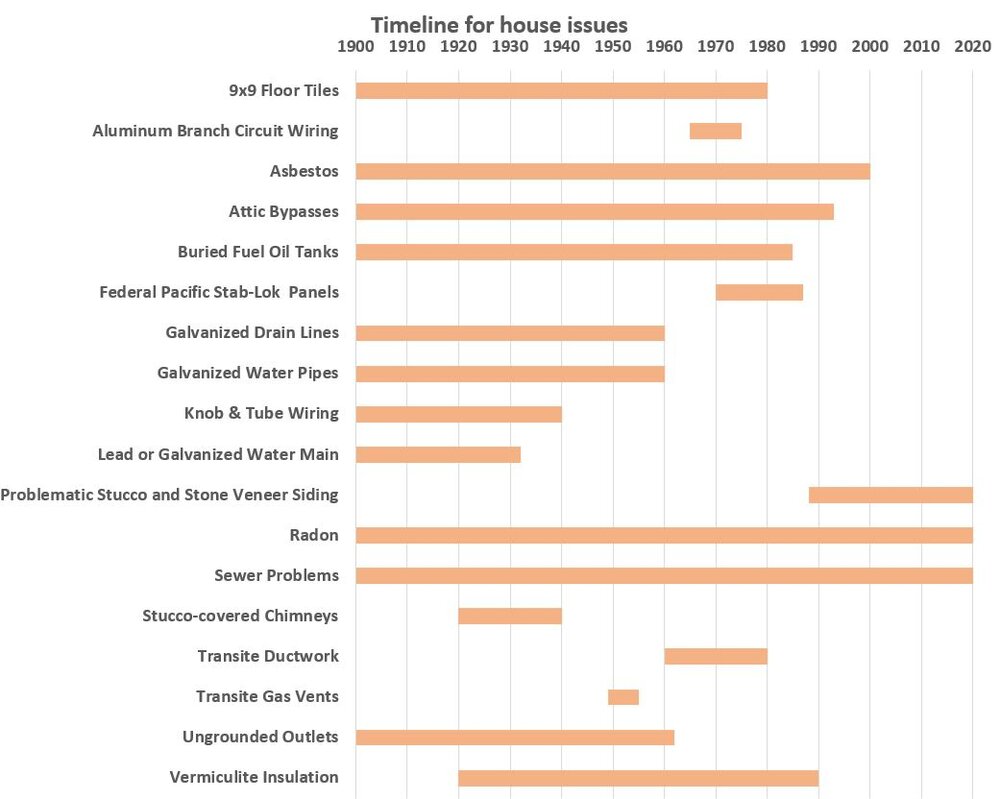Buying a used house in Minnesota? Here’s a rough timeline of potential problems to look out for. It’s impossible to make a perfect chart like this because so many of these things are generalities, but I think this chart is a great starting point to knowing what types of issues to look out for. These are definitely age-related items that I look for as a home inspector. Click on the chart for a larger view.
While we have a lot of homes in Minnesota that were built before 1900, the issues with those older homes are the same, so I didn’t go back any further in time. Also, you’ll surely have questions about why I chose the dates that I did, so I’ve included some brief explanations for each item below. This timeline provides good estimates, but as I mention in the video below several times, there are always exceptions.
9×9 floor tiles, pre-1980s: It’s safe to assume that all 9″x9″ floor tiles contain asbestos, as well as the mastic that holds them in place. The good news is that the health risks posed by 9×9 floor tiles are essentially none. The only reason I mention it on this list is that big-box retailers are unwilling to install new flooring over this material, so we typically point that out during our home inspections, simply as an FYI.
Aluminum branch circuit wiring, 1965-1975: The really bad stuff was used up until 1972. There was some other aluminum branch circuit wiring with a less-problematic alloy used for several years after that, but as a home inspector, I don’t make any attempt to figure out exactly which alloy was used. When I come across aluminum wiring, I recommend getting an electrician in to inspect it and to make repairs. Experience has taught me that many electricians aren’t aware of the difference in alloys, and they deem all aluminum branch circuit wiring to be hazardous.
Asbestos, pre-2000: This is a generality. Asbestos still hasn’t been officially banned today, but it’s highly unlikely that you’ll find asbestos-containing materials in modern homes. So where can you find asbestos in an older home? Just about anywhere. As I mentioned in my blog post on asbestos, if a material isn’t made from wood or metal, it might contain asbestos.
Attic bypasses, pre-1993: You’ll still find attic bypasses on many brand new homes built today, but it’s pretty much a guarantee you’ll have them everywhere on older homes. Up until about 1993, there wasn’t even a concept of an attic bypass, so there was never any attempt to seal them.
Buried fuel oil tanks, pre-1980: According to the fine folks at Dean’s Tank, Inc., houses built before 1930 will almost certainly have had a fuel oil tank. After that, the likelihood drops off, but you’ll still find homes in the outlying suburbs with fuel oil tanks through the 1970’s.
Federal Pacific Electric Stab-Lok panels, 1970-1987: I researched the last 100 buildings where we found Federal Pacific Electric Stab-Lok panels during our home inspections to get some good numbers for this blog post. Here’s a breakdown of the age of buildings where we found these panels:
-
1980s: 26, with the youngest home being 1987
-
1970s: 53
-
1960s: 6
-
1950s: 11
-
Pre-1950s: 4
You could potentially find these panels in any home built before 1987, but the majority of these panels are found in homes built in the 1970s and early 1980s.
Galvanized steel drain lines, pre-1960: The problem with these drain lines is that they corrode on the inside and eventually become clogged, and the only option to fix this is to replace the drains.
Galvanized steel water pipes, pre-1960: These are the distribution pipes found throughout the interior of homes. Like steel drains, they corrode on the inside the fix is replacement.
Knob & tube wiring, pre-1940: This type of wiring presents safety issues and insurance problems. See our blog post on knob & tube wiring for details. This age range is a generality, however. We recently found knob & tube wiring at a home built in 1959. No joke.
Lead or galvanized steel water main, pre-1932: These water mains lead to a major reduction in water flow, and were used in Saint Paul up until 1926, and in Minneapolis up until 1932. See lead water lines for more info.
Problematic stucco & stone veneer siding, post-1988: Newer homes have had some major problems with stucco and stone veneer siding. Check out my 84-minute water intrusion training video for detailed info on this topic.
Radon, any age: I’m adding this to the list to make it clear that radon doesn’t only affect old houses.
Sewer problems, any age: Same as radon. Older homes are more prone to sewer problems, but we’ve found major sewer problems with all ages of homes. See Sewer inspections: old homes or all homes?
Stucco-covered chimneys, 1920-1940: This is our best approximation of the age of problematic stucco-covered chimneys.
Transite ductwork, 1960-1980: See Transite vs. sub-slab ducts for more info on this topic. Sub-slab ductwork can be found on much newer homes, but it shouldn’t be called transite ductwork if it doesn’t contain asbestos.
Transite gas vents, 1949 – 1955: This is anecdotal information based on the homes where we’ve found transite asbestos gas vents, which are very bad news.
Ungrounded three-prong outlets, pre-1962: You can find ungrounded three-prong outlets at any age of home, but it’s much more common in homes built prior to 1962, which is when the electrical code first starting requiring all outlets to be grounded.
Vermiculite insulation, 1920-1990: This material was commonly used as attic insulation, and occasionally in walls. The problem is that most of this insulation contains an especially hazardous form of asbestos. See vermiculite insulation for details.


